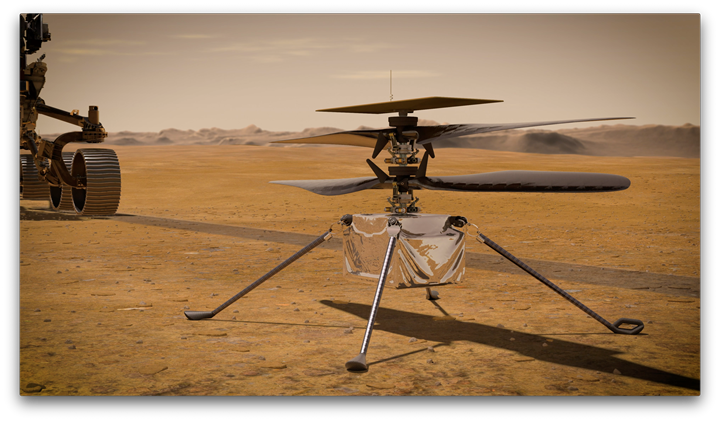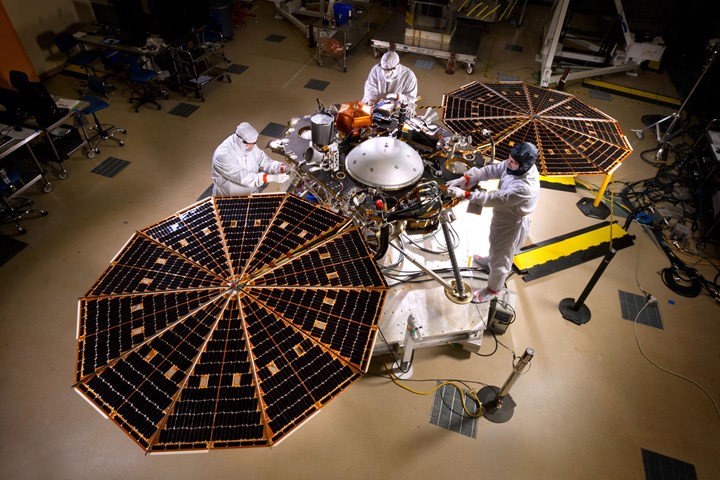Engineering an Autonomous ATV—for Mars
Farah Alibay is a mobility engineer—who works on extraterrestrial vehicles
#electronics
On July 30, 2020, at 7:50 am EDT, a United Launch Alliance Atlas V rocket lifted off from Space Launch Complex-41 in Florida, carrying the Mars 2020 mission and the Perseverance rover.
Destination: Mars!
The landing of the Perseverance rover and the Ingenuity helicopter that it is carrying is planned for February 18, 2021.

The Perseverance. Six wheels each with at least one drive motor. Front and rear wheel steering—with each wheel operating independently. Autonomous driving capability. Plutonium power. And as this artist’s rendering shows, ready to travel on Mars. (All images: NASA/JPL-Caltech)
And one of the engineers who was—and is—instrumental to the program is Farah Alibay, a Mars 2020 Flight System Systems Engineer, who has also worked on the InSight (Interior Exploration using Seismic Investigations, Geodesy and Heat Transport) lander, which is currently working on Mars (it lifted off on May 5, 2018, and landed November 26, 2018). She notes that there is another explorer on the surface of Mars, Curiosity, which launched on November 26, 2011, landed August 5, 2012, and has been at work examining rocks on the surface of the planet since in landed in the Gale Crater. Alibay says that the InSight and Curiosity are about 100 miles apart on the surface. When Perseverance lands in the Jezero Crater, it will be in a different time zone than the other two.
And mentioning time zones, here’s something that most vehicular engineers don’t have to deal with. Sure, there may be meetings when someone in the U.S. is communicating with colleagues in Europe or Japan, which means that someone is up late or getting up early.

Farah Alibay, Mars 2020 engineer. She also worked on the Mars InSight program (note the patch on her shirt), which has landed on Mars and is hard at work.
Alibay notes that the Martian day is approximately 24 hours and 40 minutes. So for the first 90 days she and her colleagues are working on Martian time—which means that each day their starting time shifts by 40 minutes. “Sometimes we go in during the day and come home at night; sometimes we work at night and come home during the day.”
The Perseverance, however, keeps regular hours. That is, it wakes up (“It literally wakes up,” she says. “Overnight it goes into a sleep mode”) between 6 and 8 in the morning Mars time. “It listens to a signal coming from Earth—its to-do list, a series of sequences and commands with instructions of what to do for the day.” Then, between 4 and 6 pm local on Mars, it sends information back to Earth. Then it goes to sleep.
And Your Point Is. . . ?
While all of this may be fascinating for the space enthusiast, what’s the point here?
Even Alibay was surprised that someone like me was interested in talking with her.
The Perseverance is arguably the most-advanced autonomous vehicle in the known Universe. That’s right: it performs full autonomous driving—Level 5. No geofencing. No steering wheel. Of course, no passengers, either.
Well, there is the Ingenuity that is along for the ride to the Martian surface. And this is germane as OEMs are working on drones, albeit not as advanced as this one. The Ingenuity is a small (1.8 kg) helicopter that has four carbon-fiber blades that are arranged into two 1.2-meter long counter-rotating rotors. They spin at about 2,400 rpm. The mass of the vehicle, the length of the rotors and the rotational speed are all to address the fact that the Martian atmosphere is just 1% as dense as that on Earth.

The Ingenuity (artist rendering) weighs 1.8 kg, is 0.49 m high, and two pairs of counter-rotating blades that span 1.2 m in diameter and spin at 2,400 rpm.
And the Ingenuity is an autonomous vehicle, too. Like the Perseverance, it receives instructions from Earth (it actually communicates via the rover).
Assuming that it arrives intact and is able to fly, it will be the first flyer to operate on another world. (Maybe in a world where many people have not known a world without Star Wars there is a certain blasé feeling about space. But read that sentence again: the first flyer to operate on another world.)
The Wright Brothers’ first flight lasted 12 seconds. The solar panels on the Ingenuity charge the lithium-ion batteries to provide enough power—350 W—for a single flight: 90 seconds. The team hopes to be able to make as many as five flights during a 30-day—Martian day—period.

Prepping the InSight, which Alibay also worked on. Its purpose is to study the deep interior of Mars.
But What About the Ground Vehicle?
The Perseverance measures approximately 3 meters long, 2.7 meters wide and 2.2 meters tall. It is fitted with a robotic arm some 7.1 meters long that has a turret on its end for the work of collecting samples in 43 tubes. The curb weight—not that there are curbs on Mars—is on the order of 1,025 kilograms.
Power is provided by the MMRTG—or “Multi-Mission Radioisotope Thermoelectric Generator”—that was provided to the mission by the U.S. Department of Energy. . .because it is powered by decaying plutonium-238.
That’s right: atomic power.
Powered by 4.8 kg of plutonium dioxide.
The generator produces 110 Watts of electricity. There are two rechargeable lithium-ion batteries on the rover to deal with peak demands.
And so I have to ask Alibay about the top speed of Perseverance. She answers.
And then I have to ask her again to make sure that I heard correctly: 152 meters per hour. About 0.1 mph.
She notes, “We don’t drive at top speed.” She adds: “This is not like having a car and putting it on cruise control. There’s a lot going on on Mars.”
The ATV in Space
“We’re essentially driving an all-terrain vehicle on Mars,” Alibay says.
The rover has six wheels. Each is made of aluminum with titanium spokes. It measures 52.5 cm in diameter. All wheels are powered by identical brushless DC motors. Each motor can handle 10 amps and generate 1,000 Nm of torque. She says that that torque can come in handy should a wheel get stuck.
Alibay notes that there are 10 actuators rather than just six because the front and rear wheels each have two motors: all of the wheels are rotated on the horizontal axis, but those four wheels can be rotated on the vertical, as well, for steering.

The Perseverance decent stage stacked on top of the rover. This image shows the underside of the rover. The Ingenuity helicopter can be seen at about the 7-o’clock position. The silver cylinders (some of which have yellow tape on them) are the aluminum wheels; the protective material was removed from the wheels prior to launch.
This isn’t four-wheel steering as used on some terrestrial vehicles. Each of the wheels operates independently. That is, each can be positioned in a different direction. Alibay says that seeing the wheels move in a sequence that is unfamiliar is, well, unusual.
The Ingenuity is housed in a belly pan for its descent to the planet. This means that when the Perseverance lands on Mars it has a ground clearance of 20 cm. But when the Ingenuity clears the rover, that clearance goes up to 60 cm.
So what can it drive over? Obstacles up to 40 cm.
Alibay explains, “The limiting factor for being able to drive over obstacles is not stability but is actually structural integrity. If it fell off an obstacle greater than 40 cm there could be structural damage. The rover, technically, if we weren’t worried about structural damage, could crawl over larger rocks.”
It is worth noting that the rover suspension (“rocker-bogie,” which has a differential that connects the left and right rockers; rockers on each on the left and right side of the rover that connect the front wheels to the differential and the bogie in the rear; and the bogie, which connects the idle and rear wheels to the rocker) is designed so that it can handle a tilt in any direction of 45°.
The Autonomous Drive
Talk to any autonomous vehicle developer who is developing systems for use on Earth and they’ll tell you that it is absolutely essential for a vehicle to “know” where it is, which isn’t just predicated on things like lidar, radar and even GPS, but on high-definition maps.
“We have orbital imagery of the surface of Mars,” Alibay says. “It is pretty good imagery, but on the order of meters of resolution, not centimeters, by any means. So we rely on the visual odometry”—determining the position of the vehicle through the analysis of camera images—"of the rover to drive.”
There are nine engineering cameras. There are six HazCams, four on the front and two on the rear. These are used for detecting hazards like rocks, trenches and sand dunes. (They’re also used to help direct the robot arm for sample collection*). There are two color stereo nav cams that are located on the rover’s mast. These collect information so the rover can determine the path it should take.
“With previous rovers”—like the Curiosity—“they could only drive as far as they could see,” Alibay says. This meant probably no further than 20 m per day. That’s because they would take pictures of the terrain ahead and send them back to Earth. Then RPs—“rover planners”—would examine the photographs and determine the path the rover should take. Then they’d send the instructions back to the rover. It would drive about a meter. Stop. Photograph. Send. Wait. Drive. . . .
“We improved that with Perseverance. It can drive autonomously because it can do what we call ‘thinking while driving.”
She explains that the Perseverance has an additional computer. The Vision Compute Element, as it is called, was put onboard in order to be able to navigate the craft while landing, to help avoid obstacles. Once on the planet’s surface, it is used for autonomous driving activities. “We can self-drive about three times faster than Curiosity.”
However, not only does the Perseverance shut down at night, but it does have to stop every now and then to refine positioning. Although the rover is using visual odometry, “there is some error in that, which grows over time,” she says. Realize that unlike autonomous vehicles on Earth, there is no GPS nor is there a compass. “We stop and look at the Sun.” That allows them to calculate the heading.
The Engineering Challenge
“On the engineering side, we’ve tested everything,” Alibay says when asked about the biggest challenges she and her colleagues are facing. “We wouldn’t be going to Mars if we weren’t sure that all of the parts were going to work.
“We don’t leave anything to luck.”
She says that when the Perseverance lands there will be concerns about determining whether anything broke, deploying the mast and antenna, and getting everything up and running.

The rover on a spin table. The purpose of the test was to determine the center of gravity for the vehicle.
“From an engineering standpoint, if something doesn’t go right, we can’t go up there and fix it.
“It is always challenging—but somewhat exciting—to try to figure out how to fix something when you can’t just take a wrench to it.”
Alibay says that they have a full replica of the Perseverance—without the plutonium generator, of course (it pulls a power cable along)—and what is called the “Mars Yard,” a giant sandbox that they put obstacles in so as to test out driving scenarios. “If issues occur on Mars, we will try to replicate them on Earth and figure out solutions.”
And there is a second rover on Earth, the “scarecrow rover,” which she says is a pared down version of Perseverance, essentially just the mobility system, so that the rover has a third of the mass of the actual craft. (Mars has about one-third the gravity as Earth.) The scarecrow allows them to put ballast on in particular locations to determine weight distribution’s effect on doing things like crawling over rocks.
Scarecrow? “It doesn’t have a brain. We operate it using a laptop.”
Unlike Perseverance, it doesn’t think and drive.
*Perseverance is a science mission. There is a drilling system that will cut rock cores to about the size of a piece of chalk and store them in a sample tube (43 tubes are carried) that will, at some point, be returned to Earth by a planned NASA/European Space Agency mission. In addition, it will look for signs of life. It has seven on-board instruments that can detect organic matter and to determine the composition of rocks and soil.
RELATED CONTENT
-
Special Report: Toyota & Issues Electric
Although Toyota’s focus on hybrid powertrains at the seeming expense of the development of a portfolio of full battery electric vehicles (BEVs) for the market could cause some concern among those of an environmental orientation, in that Toyota doesn’t seem to be sufficiently supportive of the environment, in their estimation. Here’s something that could cause a reconsideration of that point of view.
-
Lincoln Corsair Takes Flight
“We wanted to create a dramatic, youthful Lincoln with terrific harmony.” And with the Corsair, they’ve accomplished what they set out to do.
-
GM Develops a New Electrical Platform
GM engineers create a better electrical architecture that can handle the ever-increasing needs of vehicle systems


.jpg;width=70;height=70;mode=crop)






